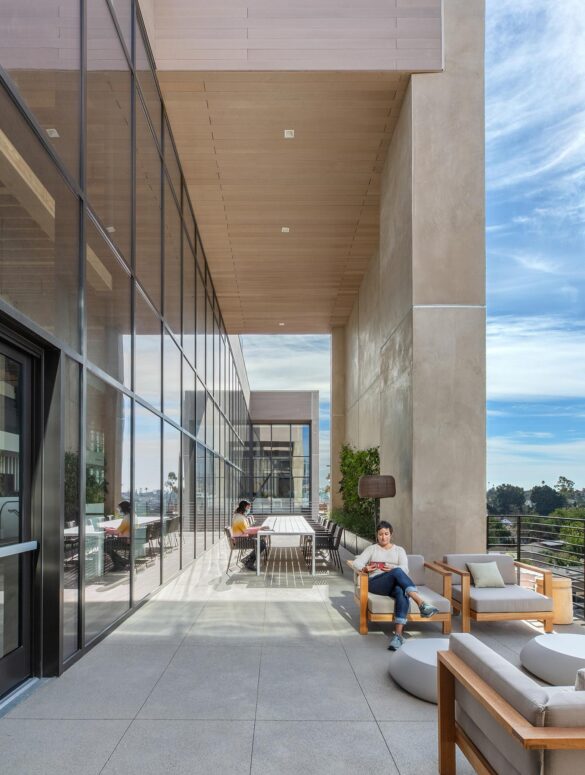Text by Nicole Ziza Bauer
Images courtesy of the Ellison Institute
“Our role here is not just to be a facilitator, but to create the future,” says Dr. David Agus, founding director and CEO of the Lawrence J. Ellison Institute for Transformative Medicine of the University of Southern California. “We’re obligated to start doing things differently.”
At the institute, a novel collaboration of medical professionals, researchers, and technologists work to neutralize the inherent panic triggered by a cancer diagnosis. The result is a state-of-the-art location that’s part laboratory, part wellness clinic, and part think tank, building upon the oncology field to address the full spectrum of health, all at one innovative Santa Monica hub.
Named after Larry Ellison, founder of the software developer and database company Oracle, the institute resulted from what Agus describes as “many long and exciting conversations” sparked by Ellison’s interest in science and medicine. The two met when Agus began treating Ellison’s nephew for cancer. They later grew close after Steve Jobs, a friend of Ellison, was also diagnosed with the disease and Agus was involved with his treatment.

Today Agus and his team are reimagining the patient experience, shifting the narrative from This is how cancer is treated to Let’s see how else we could approach this. A visit extends beyond a discussion about treatment options—it places a patient amid the latest advances in medical care, including a museum chronicling the history of cancer research, to grasp the encouraging momentum of the field. “In our first week, I had a patient come in, someone who I had taken care of for a long time, and he was in tears,” Agus recalls, speaking of the building’s impact. “He said, ‘It’s just amazing that I am able to experience this.’”
At every touchpoint, the institute has been designed to empower and educate. Glass walls bring research teams out into the open where patients are invited on laboratory tours to interact with the scientists working on their disease. That work could involve the use of Oracle-facilitated artificial intelligence to analyze thousands of patient slides, predicting through morphology which cancer genes are turned on or off and enabling more personalized treatment. Or, it could be utilizing biomimetic “organ chips” to study metastasis in the body. These fluid models offer a better understanding of the cancer environment than could previously be gained from individual cells or animal studies.

“When [patients] see those labs, that’s hope personified,” Agus says, noting how important it is for researchers to hear about a patient’s experience firsthand. “The interaction of our researchers and patients is powerful. Researchers are so motivated to do something for that patient they just met, they work harder in the lab.”
The institute’s Santa Monica location, a five-minute walk from the Expo/Bundy metro stop, heightens its potential for collaboration. Not only can students and scientists from USC’s downtown campus easily access the facility sans rush-hour traffic, but the city itself naturally woos out-of-state clinicians for research stints during the chill of winter. “We’re all in this together across the country fighting disease,” Agus stresses. “We have to think of ourselves as one team.”
For its part, the institute offers out-of-the box thinking characteristic of greater Los Angeles—a place fueled by imaginative, artistic expression. Take, for instance, the 12-foot elephant sculpture by Jeff Koons on the patio, which visually reflects the role of pattern recognition within medicine and a need to view and interpret data creatively. (Elephants, Agus explains, have a particular gene that corrects damaged DNA so they don’t develop cancer.) Part of the institute’s edge is its guiding philosophy that the answer to cancer won’t arrive squarely from biologists. It’ll likewise require a neighbor in Silicon Beach—a coder, an engineer, a thinker. Fortunately, L.A. is a place where right and left brain collide.
“We always say, ‘Knowledge is power.’ We want people to be creative, to brainstorm and be collaborative.”
Kelly Santoro
The institute’s other arm is its wellness clinic, which shares the ambition of easing access to cancer awareness, treatment, and prevention. Here, both patients undergoing treatment and those proactive about their health can benefit from the institute’s synergy. Great care is taken to ensure that health appointments aren’t something to dread, from the clinic’s warm lighting and decor to reclining chairs that turn into exam tables.
“We’re not always the best at making sure we’re seeing physicians at regular intervals and making sure everything is fine-tuned,” says physician assistant Kelly Santoro, the institute’s clinical director. To help every patient lead a healthy, fulfilling life—the clinic’s primary goal—it offers genetic screening, nutritional counseling, lifestyle recommendations, and even opportunities to join clinical trials.
It’s all part of extending health education to the greater community, Santoro says, another pillar of the institute’s mission. “We want to be open about everything and get information out there,” she says, elaborating on post-pandemic plans to bring in guest lecturers, increased tours of the institute’s History of Medicine gallery, and fellowships for high school students.
“We always say, ‘Knowledge is power.’ We want people to be creative, to brainstorm and be collaborative,” Santoro says. “At the end of the day, it all comes down to making a difference in patients’ lives.”


